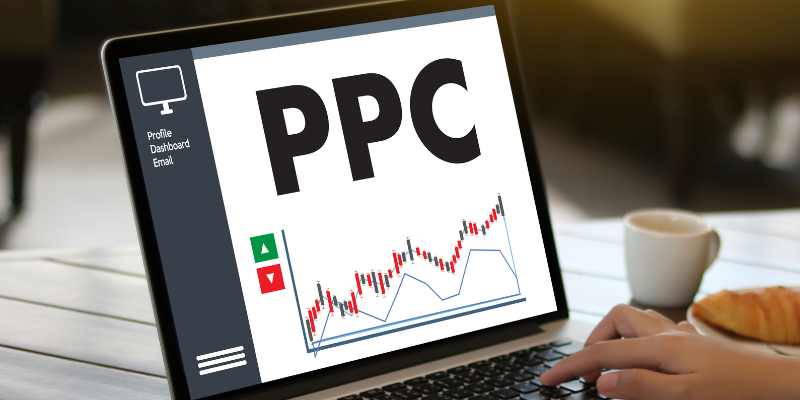Small businesses often face the challenge of limited budgets and resources, making it difficult to compete with larger, more established companies.
However, effective advertising can make a significant impact, helping small businesses increase visibility, attract customers, and drive revenue without breaking the bank.
Thus, small businesses have access to a wide array of affordable and powerful advertising tools that can give them a competitive edge.
From grassroots marketing and community engagement to online ads and influencer collaborations, there are numerous ways to put your brand in front of the right audience and achieve meaningful results.
This guide provides practical, cost-effective Small Business Advertising Ideas, with actionable tips and examples to help you maximize your marketing budget.
Whether you're just starting out or looking to refresh your advertising strategy, these ideas can help you reach your goals and stand out in the crowded marketplace.
What To Do Before Advertising Your Small Business?
Before diving into paid ads or promotional campaigns, it’s essential to lay a solid foundation. This includes understanding the core of your business and figuring out how to make the most of your advertising budget.
For example, in high ticket affiliate marketing, focusing on a specific niche can help you tap into profitable affiliate partnerships.
Equally important is choosing the right platforms. Are you looking to quickly search for relevant market data, or are you targeting business customers in B2B vs. B2C markets? Understanding these foundational elements will enhance your chances of success.
Do you want to increase brand awareness, generate leads, drive sales, or foster customer loyalty?
Here are some important steps and elements to get in place before you start advertising your small business:
1. Identify Your Target Audience
Know exactly who your ideal customer is, including demographics, behaviors, and pain points. This ensures your marketing message reaches the right people.
2. Clarify your value proposition
Clearly state what makes your product or service unique. This helps potential customers understand why they should choose you over competitors.
3. Determine your brand identity and visuals.
Decide on your logo, colors, tone of voice, and style. Consistent branding builds trust and recognition across all channels.
4. Map your customer journey
Understand how people discover, consider, and buy from you. This helps you create relevant messages at each stage.
5. Choose your core marketing channels
Focus on platforms where your audience spends their time like social media, email, or search engines. Don’t spread yourself too thin.
6. Build a functional, mobile-friendly website
Make sure your site is fast, responsive, and easy to navigate. A smooth user experience keeps visitors engaged and drives conversions, something that providers of B2B web development services prioritize when designing platforms tailored for business users.
7. Set up basic lead capture on your site
dd forms, pop-ups, or newsletter signups to collect visitor information. This allows you to build a database for future marketing. This is a key strategy often implemented by a B2C web development agency to help brands grow their email lists and nurture potential customers effectively.
Once you’ve all these in place, Centric can help jumpstart how to advertise your business.
Highly Effective 15 Small Business Advertising Ideas
This is where you begin creating content, fostering relationships, and discovering new methods to connect with the right audience. One key part of your advertising strategy should be selecting the right platform for your business. If you're trying to reach a broader audience, consider advertisement examples on platforms like Facebook and Google.
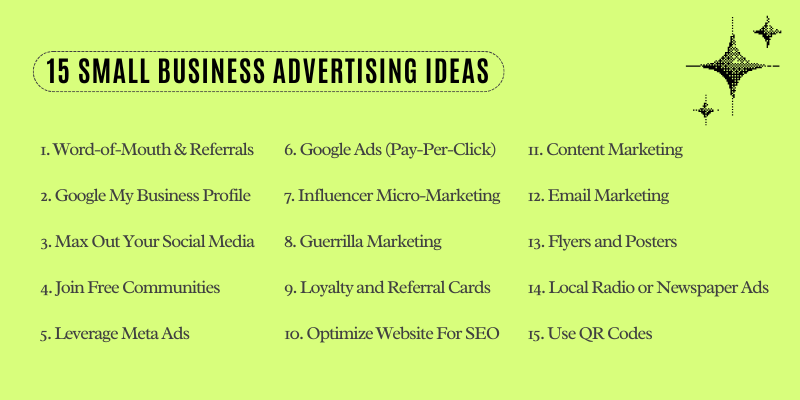
Depending on your business, what is network marketing can also be a viable advertising method, especially if you're targeting specific customer groups with a strong community focus.
The strategies outlined below have proven to be the most effective for early-stage startups and small teams.
Some help you establish a strong foundation, while others focus on maintaining consistency or broadening your reach.
You don’t need to implement all of them, just choose a few that are manageable, test what works, and build upon those insights.
1. Word-of-Mouth and Referrals
Word-of-mouth marketing remains one of the most effective, low-cost advertising strategies for small businesses.
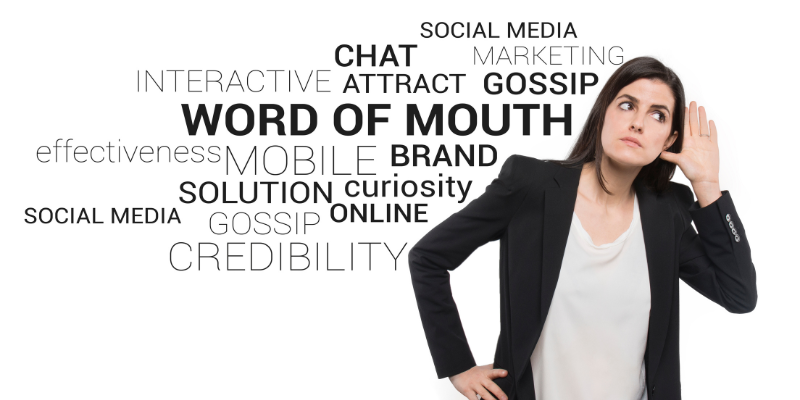
Here’s how to create a successful referral program:
- Make it timely: Ask for a referral immediately after a positive purchase, review, or support interaction.
- Make it easy to share: Provide a simple referral link, pre-written message, or QR code to make sharing effortless.
- Make it count: You don’t need an elaborate rewards system. A discount, early access, or small freebie is enough to show appreciation.
- Make it visible: Promote your referral program on your website, emails, invoices, and other customer touchpoints to ensure visibility.
To make your referral program successful, make sure the rewards are attractive and easy to claim, and promote the program on your website, social media, and email newsletters to maximize its reach.
2. Google My Business Profile
A Google My Business (GMB) listing is a free, powerful tool for local businesses to improve their online presence and attract new customers. For local SEO, understanding best SEO tools for small businesses is crucial for optimizing your profile and increasing visibility in search results. Additionally, integrating noindex tags for non-essential pages helps avoid indexation of irrelevant pages, ensuring your content ranks effectively.
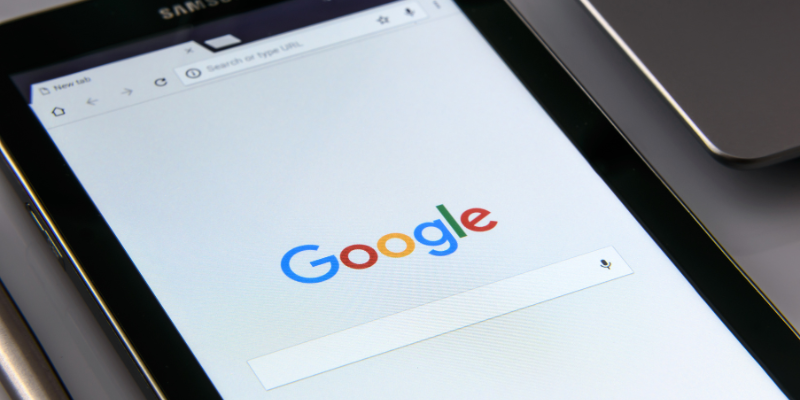
Optimizing your GMB profile can drastically enhance your visibility in local search results, especially for those looking for services "near me." This free tool helps you manage how your business shows up on Google Search and Maps, making it easier for nearby customers to find you when they’re ready to make a purchase.
Here’s how you can optimize it:
- Personalize your profile: Include your business name, address, phone number, business hours, and online store link. Upload photos showcasing your products, team, or space. A complete profile builds trust with customers.
- Encourage reviews: Request reviews from satisfied customers. A simple follow-up message or email can encourage them to share their experiences. Be sure to respond to reviews, even just to thank them.
- Keep your profile updated: Use your profile to share special offers, events, or announcements. It’s quick and gives customers a reason to engage with your business.
Make sure to claim and complete your business profile by adding accurate information, such as your business name, address, phone number, website, business hours, and photos.
3. Max Out Your Social Media
Social media is one of the most effective tools for connecting with your audience. Platforms like Facebook and Instagram offer direct access to customers, whether you’re starting small or scaling up.
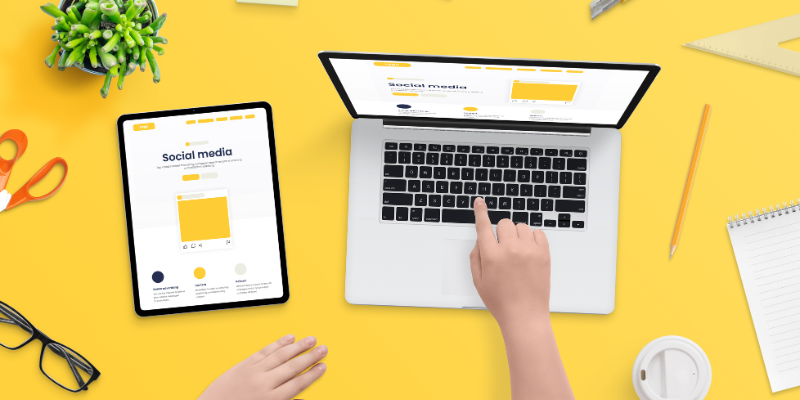
Here’s how to get the most out of your social media efforts:
- Use automation tools: Tools like Sprout Social and Buffer help you create and schedule posts in advance.
- Create a content calendar: Plan your posts ahead of time (even in a Google Sheet) to maintain consistency and engagement.
- Engage with your audience: Respond to comments, join relevant conversations, and interact with related content to build relationships.
- Leverage local communities: Use Facebook groups, hashtags, and tagging on Instagram and Twitter (X) to expand your reach and attract local customers.
Explore Our Content Creation Services!
4. Join Free Communities
There are countless online communities that can help you grow your business. By joining industry-related forums and networks, you can engage with experts, build relationships, and establish your authority.

For example, oil and gas marketing agencies can find value in these communities to connect with like-minded professionals and enhance their industry presence.
These communities are a great way to get support for local SEO efforts. For those businesses looking to improve their online presence further, enterprise seo services can be a valuable addition to your marketing strategy, helping to enhance website rankings across multiple platforms.
Here are some top options:
- LinkedIn: Join LinkedIn groups to network with other business owners and share updates about your business.
- Reddit: Participate in relevant subreddits and engage in meaningful discussions.
- Quora: Answer industry-related questions to demonstrate your expertise.
- Facebook Groups: Join groups where your target audience is active and offer valuable insights.
- Trailhead: Become part of Salesforce’s free online learning community to connect with peers and share your knowledge while expanding your business network.
This approach nurtures loyalty, promotes word-of-mouth, and helps you build a dedicated customer base.
5. Leverage Meta Ads
Meta Ads encompass all advertising opportunities within the Meta (formerly Facebook) ecosystem, which includes platforms like Facebook, Instagram, Messenger, and the Audience Network. Meta Ads are a great way to target specific demographics and can drive highly relevant traffic to your business. When considering the google ads cost, Meta platforms like Facebook and Instagram often provide a more cost-effective solution for reaching local audiences.
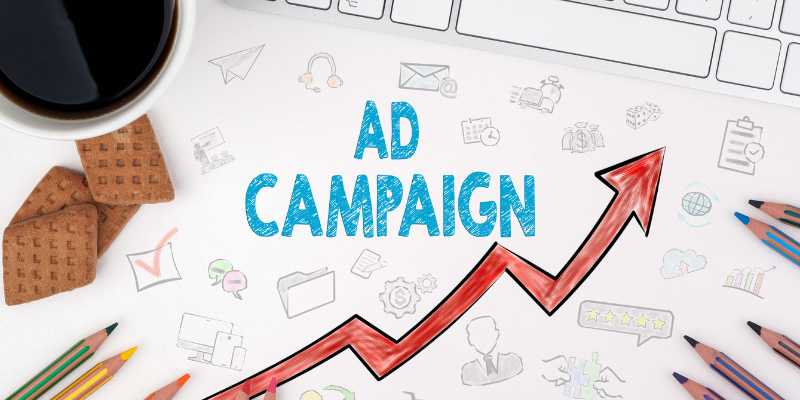
Moreover, with their ability to retarget ads, Meta Ads allow you to experiment with different advertisement examples to see which ads generate the best return on investment.
These platforms offer powerful advertising tools for small businesses to target specific audiences, drive engagement, and grow their reach.
By using white label SEO services, small businesses can improve their website's search engine optimization efforts alongside their paid campaigns, ensuring that the organic reach aligns with the paid advertising strategy.
Here's how Meta Ads can work for your business:
-
Facebook Ads: Facebook offers a wide range of ad formats like carousel, video, and image ads, allowing businesses to target specific demographics and interests. It’s ideal for building brand awareness and driving local sales.
- Instagram Ads: Instagram’s visual platform is perfect for industries like fashion, beauty, and food, with ads appearing in feeds, stories, and reels. It’s great for targeting younger audiences, especially Gen Z and Millennials.
-
Messenger Ads: Messenger ads enable direct, personalized communication with users through sponsored messages, perfect for offers, promotions, and customer service. It enhances one-on-one engagement with customers.
-
Audience Network Ads: Meta’s Audience Network extends your ad reach to third-party apps and websites, ensuring greater visibility and broader audience capture beyond Facebook and Instagram.
- Lead Generation Ads: Lead generation ads on Facebook and Instagram allow users to easily fill out forms within the platform, ideal for capturing leads for newsletters, sign-ups, or promotions.
- Retargeting Ads: Retargeting ads help re-engage users who’ve interacted with your brand before, increasing conversion chances by reminding them of your products or services.
-
Shopping Ads: Shopping ads on Facebook and Instagram allow users to view product details and make purchases directly within the app, offering a seamless shopping experience for e-commerce businesses.
-
Dynamic Ads: Dynamic ads display personalized product recommendations based on a user’s previous interactions with your site or app, enhancing relevance and increasing conversion rates.
Meta Ads provide powerful targeting options, budget flexibility, and access to a wide range of creative ad formats.
The ability to target highly specific audiences based on location, interests, behaviors, and demographics makes Meta Ads a cost-effective and efficient way for small businesses to grow.
6. Google Ads (Pay-Per-Click)
Google Ads allows small businesses to get in front of potential customers at the exact moment they are searching for products or services. By targeting keywords with local intent, you can reach people looking for businesses in your area, increasing the chances of conversion. This approach works particularly well for service-based businesses.
To further enhance your ad performance, use call extensions to enable users to call your business directly from the ad, and leverage Google Maps ads to show up on local searches.
These tactics can drive foot traffic to your business or generate inquiries, all while staying within your budget.
Explore Our Performance Marketing Services!
7. Influencer Micro-Marketing
Collaborating with local or niche influencers is a cost-effective way to promote your business. These influencers often have highly engaged, niche audiences that align well with small business products.

Instead of paying for large, expensive campaigns, you can barter services or products in exchange for exposure.
This method not only saves money but also creates authentic content, as influencers typically provide more organic, trusted recommendations to their followers.
8. Guerrilla Marketing
Guerilla marketing is all about using unconventional, eye-catching promotional tactics that capture attention and create memorable experiences.
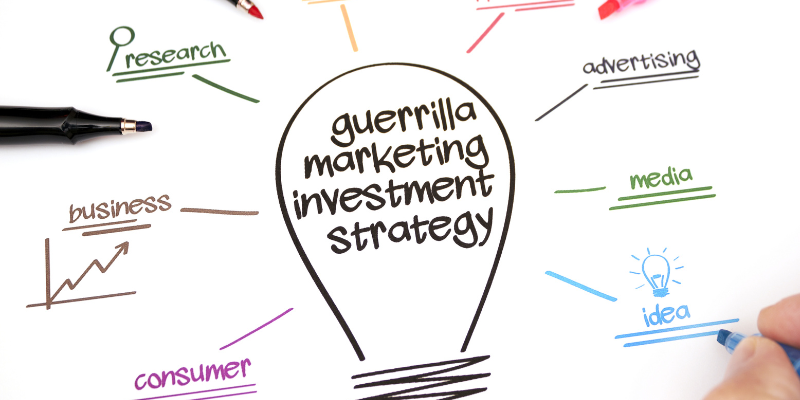
These methods often take place in unexpected locations, using creativity to surprise and engage the audience. The goal is to make a big impact with minimal resources.
Examples of guerilla marketing tactics include chalk art on sidewalks, creating vibrant visuals that draw passersby’s attention, or organizing flash mobs that create a buzz around your brand.
9. Loyalty and Referral Cards
Loyalty and referral cards are powerful tools for encouraging repeat business and fostering customer advocacy.
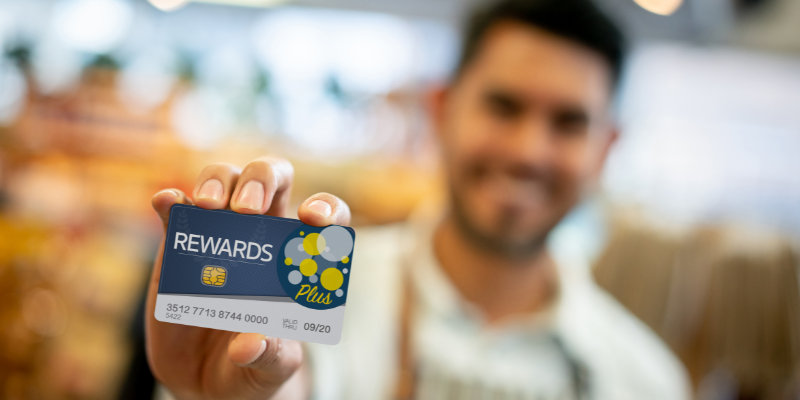
These cards can be used to reward customers for their purchases or actions, like signing up for your email list or referring friends.
For instance, offering a discount after a certain number of purchases or a free product after several referrals keeps customers engaged and incentivizes them to return.
Additionally, utilizing Best Advertising Platforms can help you promote your loyalty program to a wider audience.
Combining digital and physical formats of loyalty cards can increase convenience and accessibility.
While physical cards can be handed out in-store, digital versions can be managed through apps or loyalty programs, providing customers with an easy way to track and redeem rewards.
This dual approach ensures that you cater to all types of customers while enhancing their experience with your brand.
10. Optimize Your Website For SEO
If your website isn't appearing on search engines like Google, you’re missing out on a significant number of potential customers.

Search engine optimization (SEO) helps your site rank higher in search results, making it easier for people to find you when they’re looking for businesses like yours.
For e-commerce businesses, seo services for ecommerce sites can ensure your products appear on relevant search engine results, driving more organic traffic and increasing sales over time.
SEO essentially tells search engines what your business does, where you are, and why you’re relevant.
While SEO may take time to build with quality content, it provides long-term, organic results at no extra cost.
Here are some essential SEO tips to optimize your site:
- Use the right keywords: Identify the keywords your target customers might use in Google searches, such as “affordable marketing tool for SMBs.” AI-generated overviews (AIOs) now also summarize your content, so make sure your site is optimized for that as well.
- Curate for AI overviews (AIO): Focus on providing clear, concise answers to common questions, as AIOs often pull from these to appear at the top of search results.
- Build dedicated landing pages: Each of your main products or services should have its own landing page filled with relevant keywords, making it easier for search engines to understand and rank your offerings.
- Check out competitors: Analyze what content ranks for similar businesses. What topics do they cover? How is their content structured? Use this research to create better, more engaging content.
- Make it mobile-friendly: Since more people browse on their phones than desktops, a mobile-optimized website is essential for both user experience and higher search rankings.
- Keep it fast: Slow-loading websites frustrate visitors and affect rankings. Use free tools like Google PageSpeed Insights to check and improve your site’s speed.
By applying these SEO techniques, you can increase your website's visibility and attract more customers, ensuring your business gets the attention it deserves on search engines.
Explore Our Search Optimization Services
11. Content Marketing
Starting a blog or knowledge hub on your website is a great way to provide value to your audience while enhancing your SEO efforts. What is illustration? It’s the use of visuals like graphics and drawings, which can greatly enhance your content and improve engagement.

By sharing evergreen content, such as how-to guides, tutorials, industry insights, and product tips, you can position your business as an expert in your field.
Evergreen content is content that remains relevant and useful over time, providing long-term traffic and engagement.
Regularly publishing valuable blog posts will not only attract more visitors to your website but also improve your search rankings, as search engines prioritize websites with regularly updated, informative content.
12. Email Marketing
Email marketing allows businesses to build direct relationships with customers by sending them targeted messages.
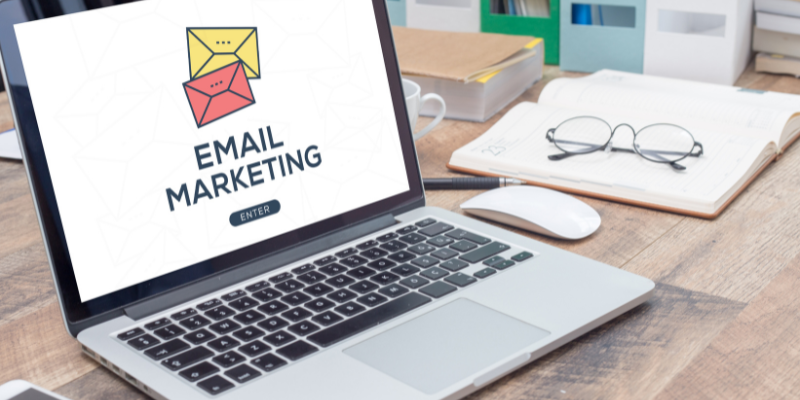
The digital marketing strategy that tracks users across the web (such as retargeting) can be extremely helpful in email campaigns, ensuring that you are reaching potential customers with highly personalized offers.
By building a subscriber list (through opt-ins on your website or social media), you can nurture your leads and existing customers with personalized emails.
Offering exclusive promotions, updates, and product recommendations through emails helps keep your audience engaged and increases the likelihood of repeat business.
Segmenting your email list based on customer interests and behaviors will also make your campaigns more relevant, leading to better open rates and conversions.
Explore Our Email Marketing Services!
13. Flyers and Posters
Flyers and posters are cost-effective offline advertising tools that can help increase brand visibility in your local community.

To maximize their impact, make sure your flyers and posters are visually engaging, convey your message clearly, and feature special promotions or calls to action that encourage people to take the next step.
Here are some key tips to consider:
- Use bold, eye-catching designs: Choose colors and fonts that grab attention but remain legible. Make sure your branding is consistent with your other marketing materials.
- Include a clear call to action: Whether it’s "Visit us today," "Call now for a special offer," or "RSVP to this event," give people a reason to take action.
- Offer an incentive: Provide a discount, giveaway, or limited-time offer that will encourage people to engage with your business.
- Strategically place them: Put your flyers and posters in places where your target audience frequently visits, such as local coffee shops, gyms, or community boards.
By following these tips, you can create impactful flyers and posters that will grab attention and help drive traffic to your business.
14. Local Radio or Newspaper Ads
Advertising through local radio stations or newspapers is a great way to reach a targeted, localized audience.

Radio ads are especially effective for reaching people who listen during their commute or while at home, while newspapers still hold value for certain demographics, particularly older generations or individuals who prefer reading physical copies.
If you are a local business, combining traditional methods with affordable local seo services can help you reach customers both offline and online, ensuring a comprehensive marketing strategy.
Both options are often more cost-effective compared to larger media outlets and provide the opportunity to specifically cater to local markets.
When creating ads, make sure to craft a compelling message that highlights what makes your business unique and how it directly benefits the local community.
15. Use QR Codes
Yes, QR codes can be a powerful tool for advertising your small business.
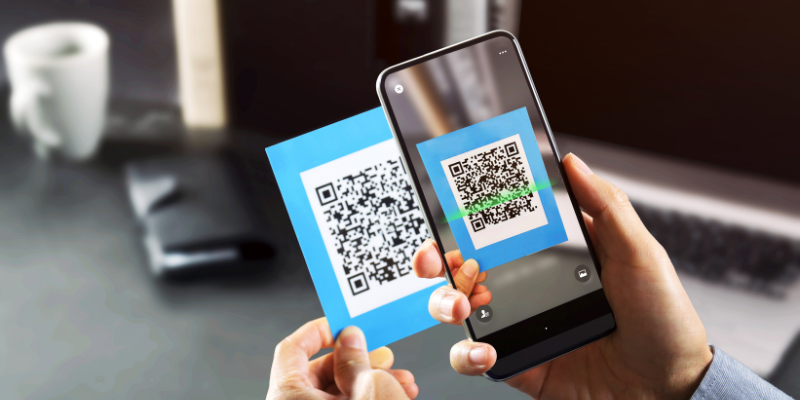
They provide a quick, easy way for customers to engage with your business and access additional information without typing a URL or searching online.
Here’s how you can effectively use QR codes in your marketing strategy:
- Link to Your Website: Add QR codes to flyers, posters, or business cards to direct customers to your website, making it easy for them to explore your offerings.
- Promote Special Offers: Place QR codes on in-store signage or menus for discounts and promotions, encouraging immediate purchases.
- Drive Social Media Engagement: Use QR codes to link to your social media profiles, helping you gain followers and increase engagement.
- Simplify Event Registration: Include QR codes on event materials for easy sign-ups, making registration quick and seamless.
- Collect Customer Feedback: Link QR codes to surveys or feedback forms on receipts or in-store displays to gather customer insights.
- Enhance In-Store Experience: Place QR codes on product labels or displays to provide more details, videos, or reviews, enhancing the shopping experience.
By integrating QR codes into your advertising, you can streamline customer interactions and make it easier for people to connect with your business, boosting engagement and driving sales.
4 Advertising Mistakes to Avoid
Effective advertising requires strategic planning and execution, but even small missteps can lead to wasted resources and missed opportunities.
For example, ignoring mobile optimization could cost you conversions, as what are five marketing strategies that retailers spend half of their annual budget on? include digital tools designed for mobile.
Additionally, not tracking performance means missing out on optimizing campaigns. It’s important to continuously test and refine your approach to ensure it aligns with the audience's needs and preferences.
Avoiding these common mistakes will help you maximize the impact of your advertising efforts and ensure better returns on your investment.
- Not tracking performance: Failing to monitor key metrics like impressions, clicks, and conversions makes it impossible to assess and optimize campaign effectiveness.
- Ignoring mobile optimization: Ads and websites that aren’t optimized for mobile devices can frustrate users and result in lost customers.
- Spreading your budget too thin: Allocating your budget across too many channels dilutes the effectiveness of your campaigns. Focus your resources on a few well-targeted platforms for better results.
- Focusing only on digital or only on traditional channels: Limiting your strategy to just one form of advertising restricts your reach. A balanced approach that combines both digital and traditional methods ensures broader audience engagement.
FAQs: Small Business Advertising Ideas
What are the most effective small business advertising ideas?
The most effective small business advertising ideas often include a mix of word-of-mouth marketing, Google My Business optimization, social media engagement, and local SEO. These strategies help build brand visibility, attract local customers, and maximize the return on your advertising spend. By combining free and paid methods, small businesses can reach their target audience without exceeding their budget.
How can I advertise my small business on a budget?
To advertise your small business on a budget, consider using free advertising methods like social media marketing, email campaigns, and Google My Business. Focus on local SEO, create engaging content, and leverage referral programs to increase word-of-mouth marketing. These budget-friendly methods can help boost visibility and drive traffic without significant upfront costs.
What are the best free advertising strategies for small businesses?
Some of the best free advertising strategies for small businesses include optimizing your Google My Business profile, leveraging social media platforms, and creating a strong content marketing strategy. Engaging with local communities online, offering referral programs, and building relationships with influencers can also help drive organic traffic and enhance brand awareness.
How do I promote my small business locally without spending a lot?
To promote your small business locally without spending much, start by optimizing your Google My Business listing and engaging with local customers through social media. Attend local events, join community groups, and create partnerships with other local businesses to expand your reach. Free advertising options like these can significantly increase your presence without draining your resources.
What are some innovative advertising ideas for small businesses?
Innovative advertising ideas for small businesses include guerrilla marketing, leveraging local influencers, and creating viral content that resonates with your audience. You can also explore user-generated content, partnerships with other small businesses, and free advertising on platforms like Instagram, LinkedIn, and Facebook to creatively engage your community and drive traffic.
Conclusion
Advertising for small businesses doesn’t have to be expensive or overwhelming. By combining creative, low-cost tactics with smart digital strategies, you can achieve significant results without exceeding your budget. The key is to experiment with different methods, track performance, and double down on successful campaigns. This approach ensures that your advertising efforts are not only cost-effective but also impactful.
Whether you’re just starting your business or looking to refresh your advertising strategy, these small business advertising ideas will show you how to promote your business locally and reach your goals. From word-of-mouth marketing to local SEO and paid ads, these are ways to promote your business, including free advertising how to advertise online.
With consistency, creativity, and a focus on customer needs, your small business can effectively compete and thrive, no matter how large or established your competitors are. By making strategic choices and optimizing your campaigns, you'll position your business for long-term success in a competitive market.


